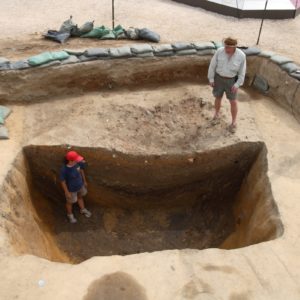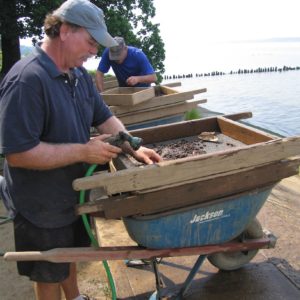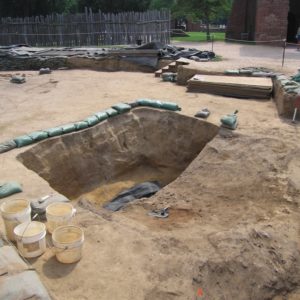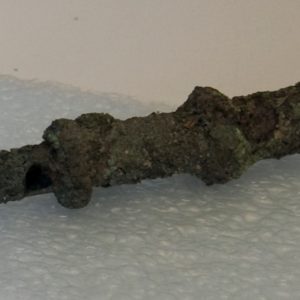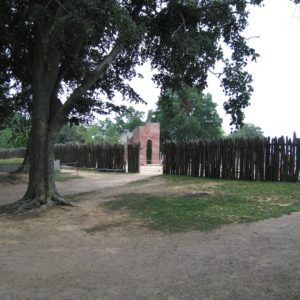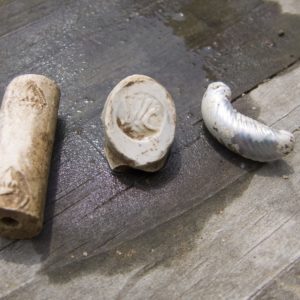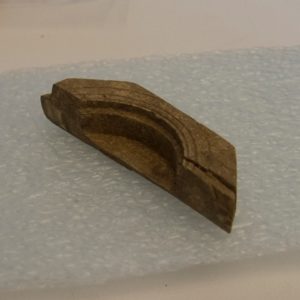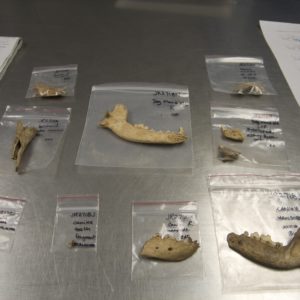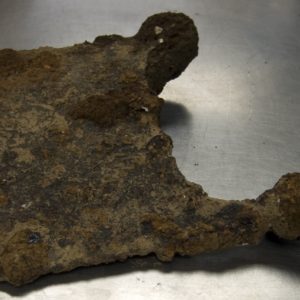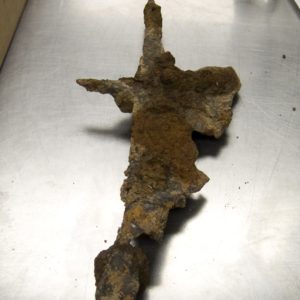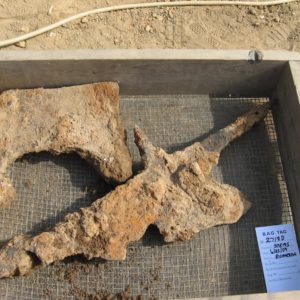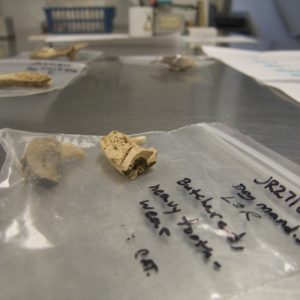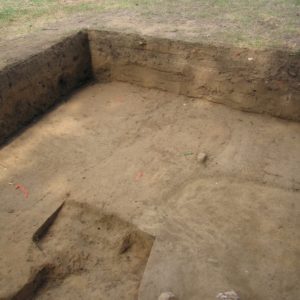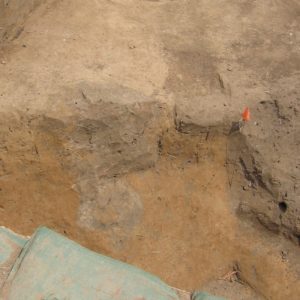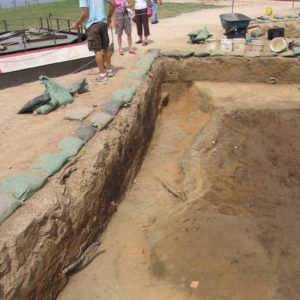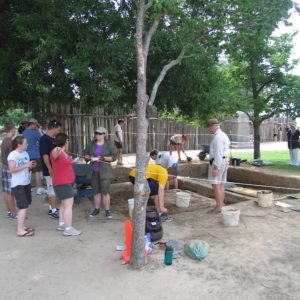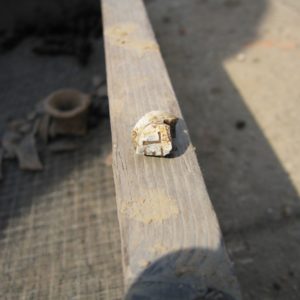The 2009 field school is in session and the students and their Jamestown Rediscovery instructors are focused on an area inside the eastern palisade wall and on a probable well near the center of the fort. The group of students just inside the eastern palisade wall are in search of fort-period structures. More specifically they are looking for postholes about ten feet from the wall that may have belonged to post-in-ground buildings. Other fort-period (ca. 1607-1624) structures parallel to the palisade walls were found at this distance. Another group of archaeologists are excavating the fill of what is almost certainly a well, probably the fort’s first. Thousands of artifacts have been found so far, with some of the latest including a slate tablet with words, numbers, and drawings etched in it, a bill head—the metal portion of a polearm weapon called a bill—a portion of a compass made from ivory or bone, and a collection of bones from at least nine dogs (every indication is that these are dog bones though this has not yet been verified). Some of the bones exhibit signs of butchering—an indication that at least some of the dogs were eaten. Dogs were not normally eaten by the English, and this—in addition to the butchered horse bones mentioned in May’s update—indicate that the colonists were desperate for food. If this well is indeed the first one built in the fort, then it would have been in existence during the “Starving Time” winter of 1609-1610, and these bones seem to confirm the desperation of the colonists.
Searching for fort-period buildings inside the eastern palisade wall, a group of archaeologists and field school students are excavating an area just feet from where the wall once stood. If the buildings along the eastern wall followed the pattern of those built inside the western and southern walls then they should have been built about ten feet away from the wall, leaving a passageway between the structure and the fort wall. The excavations so far have unearthed a few postholes, but more digging needs to be done to see if these are part of a larger pattern indicating a structure. These excavations are close to the still-standing church tower, and like other digs near the church, graves are being found. At this point six have been discovered by the students and staff in this area of the site. As with other graves found in and around James Fort, these will not be disturbed.
A layer of brick rubble and mortar has been found while excavating this area and it is thought that this is the result of bricks being strewn across the churchyard after the church burned for the second time in the late 17th century. Still-viable bricks would have been reused while the broken ones appear to have been left on the ground along with mortar and some 300-plus-year-old mud daubers’ nests which originally were probably high on the church’s walls.
Near the center of the fort work continues on what is probably the fort’s first well, built under the direction of Captain John Smith in early 1609. Up until that point, according to colonist George Percy, “our drinke [was] cold water taken out of the River, which was at floud, verie salt, at a low tide full of slime and filth.” Over the last few months one half of the well has been excavated to a depth of about five feet. Currently the other half is also being excavated to that level. Before digging deeper than five feet, a steel casing will be placed in the well to protect the archaeologists. Recent finds include a slate tablet with numerous sketches of flora and fauna, from both the old world and the new, as well as etchings of words, numbers, and human figures (for more on the slate, see our press release), a head from a bill—a type of polearm weapon resembling a halberd—a piece of a compass made from ivory or bone, a spade nosing, and bones from nine different dogs, some of which bear tell-tale butchering marks.
Artifacts found in the well so far indicate that it dates to very early in the colony’s history and is most likely the very first well dug in 1609, a probability also evidenced by its location at the center of the fort, which would have presented the colonists in the fort with the most convenient location. The remains of nine dogs and at least one horse—many of which have butchering marks on them—suggest that this well was being used as a trash pit during or shortly after a period in which the colonists were desperately hungry. In normal times, the colonists would not butcher their transportation or their pets and hunting companions for nourishment. It is very possible that these butchered bones are evidence of the “Starving Time” winter of 1609-1610, a period of bitter cold and little food. Relations with the local Indians had turned sour at this point and they refused to trade for food as they had in the past. Colonists venturing outside of the fort in search of food were killed by them. According to Captain John Smith, only 60 of the 215 colonists survived the winter.
Just next to the well is a posthole that matches the existing postholes of the fort’s storehouse, also built in the center of the fort though before the construction of the well. This posthole confirms the width of the storehouse of 16 feet.
A baby whistle and teething coral found last month is being conserved and the removal of some of the corrosion has revealed that the object is silver, though with a high copper content. The high copper content allows for the amount of corrosion on the whistle.
related images
- Profile of the pit feature
- Bill Kelso sharing a find with visitors
- Archaeologists Dan Smith and Chuck Durfor screen for artifacts from the well fill.
- The probable well feature. Note that only half of the well’s width has been excavated down to five feet.
- Field school students and archaeologists screen excavated dirt from the well in search of small artifacts.
- Baby whistle and teething stick. Note the silver is starting to emerge on the left side as conservation progresses.
- The church tower and western palisade wall
- A piece of a clay pipe with fleur-de-lis decorations, a pipe heel with the letters WC, and a decorative piece of Venetian glass
- A part of a compass made out of either bone or ivory
- Various dog bones found in the well fill
- A spade nosing
- The head of a bill (type of polearm weapon)
- Bill hook and shovel spade from the pit
- A butchered dog mandible
- Another butchered dog mandible
- The outline of a grave found near the church tower. Six have been found so far in the excavations inside the eastern palisade wall.
- Cross-section of the newly-discovered storehouse posthole
- The well (sprayed with water to provide contrast) at right butts right up to a moat(ditch at center) that surrounded a Confederate artillery emplacement.
- Field school students conduct excavations just inside the eastern palisade wall under the supervision of head archaeologist William Kelso.
- The heel of a clay pipe bearing the letters EL. This was the mark of Bristol pipemaker Edward Lewis, ca. 1631-41.



